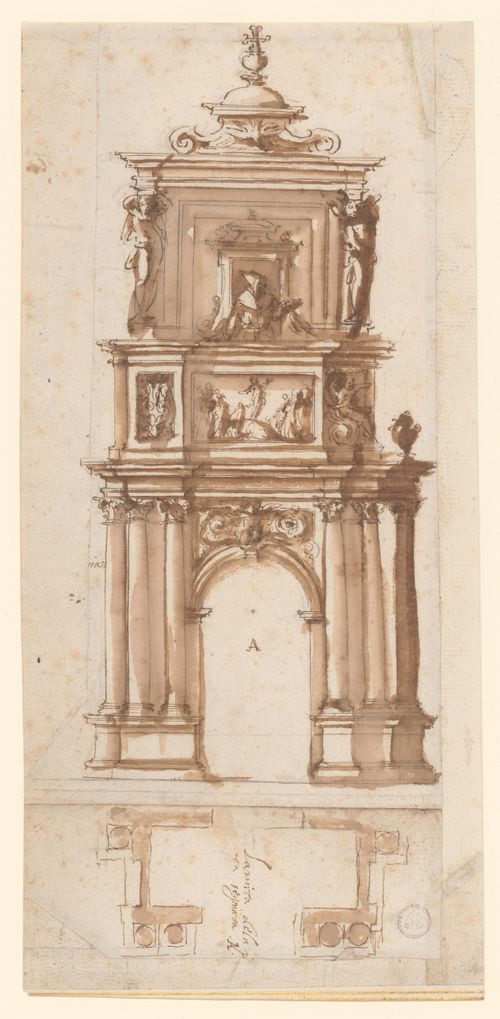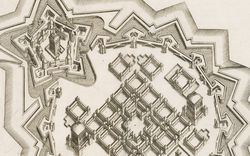Projet
AP178.S1.1971.PR01
Description:
This project series documents the Banco Pinto & Sotto Mayor in Oliveira de Azeméis, Portugal. While the records were held in the office’s archives this project was assigned the number 5/70. In the past the office identified the project as number 130. The office assigned the date 1971-1974 for this project. This project was a three storey bank on the corner of the main square of Oliveira de Azeméis. The building was surrounded by a courthouse and a 17th century home. It included a reception office, strong-room, changing rooms, and sanitary installations. The building was built in concrete between the years 1971 and 1974. The project series contains sketches and studies, as well as working drawings and floor plans. Textual materials include project documentation and correspondence. The photographs and slides primarily document the model and built project.
1971-1974
Banco Pinto & Sotto Mayor [Pinto & Sotto Mayor bank], Oliveira de Azeméis, Portugal (1971-1974)
Actions:
AP178.S1.1971.PR01
Description:
This project series documents the Banco Pinto & Sotto Mayor in Oliveira de Azeméis, Portugal. While the records were held in the office’s archives this project was assigned the number 5/70. In the past the office identified the project as number 130. The office assigned the date 1971-1974 for this project. This project was a three storey bank on the corner of the main square of Oliveira de Azeméis. The building was surrounded by a courthouse and a 17th century home. It included a reception office, strong-room, changing rooms, and sanitary installations. The building was built in concrete between the years 1971 and 1974. The project series contains sketches and studies, as well as working drawings and floor plans. Textual materials include project documentation and correspondence. The photographs and slides primarily document the model and built project.
Project
1971-1974
DR2007:0054
seconde moitié du XVIIème siècle
DR1975:0018
Description:
A three-tiered tabernacle, with corinthiancolumns, caryatids, and a putto over the arched entrance,
architecture
1580-1621
Elevation and plan of a tabernacle
Actions:
DR1975:0018
Description:
A three-tiered tabernacle, with corinthiancolumns, caryatids, and a putto over the arched entrance,
architecture
oeuvres d'art
DR1990:0060
architecture
1606
oeuvres d'art
1606
architecture
articles
Désenchantements technologiques
17th century, 18th century, BLDGBLOG, feral city, fortifications, Geoff@CCA, Geoff Manaugh, Giacomo Fusto Castriotto, Girolamo Maggi, traités, treatises, ville sauvage, XVIe siècle, XVIIe siècle
22 juin 2010
Désenchantements technologiques
Album on South Asian domestic architecture showing ornaments, crafts and trade advertisements
PH1979:0432
Description:
This album titled Indian Domestic Architecture, is by Lockwood de Forest and a combination architectural book and trade catalogue. It reflects de Forest's goal to ensure the preservation of the arts, crafts and trades (with a particular attention given to carving) of South Asian workmen. 25 heliotype plates show Indian architecture and ornaments and the final 14 pages show advertisements, in the Indian graphic style, for various New York building craftsmen and home furnishers. The album comprises a title page, an Introduction by Lockwood de Forest, a list of contents, plates by Heliotype Printing Co., Boston and engravings. Contents I. House at Ahmedabad, 16th century II. House at Ahmedabad, 17th century III. House at Ahmedabad, 18th century IV. Copy of one of the Bhudder windows at Ahmedabad, full size 7 ff. x 10 ft. made by Mr. de Forest's men and sold to the South Kensington Museum V. Copy of the second Bhudder window in Mr. De Forest's possession in New York. VI. Front of a house at Ajmere VII. Tomb of the time of Akbar, red sandstone VIII. Marble tracery in the palace, Delhi IX. Window of a house at Amritza X. Brass door at Amritza XI. Front of a house at Lahore XII. Front of a house at Lahore XIII. Front of a house at Lahore XIV. Doorway of house, red sandstone, Multan XV. Front of a house at Multan XVI. Door of house, Multan XVII. Window of tomb in tile at Multan XVIII. Doorway of house, red sandstone, Multan XIX. Mr. De Forest's rooms, 9 East 17th Street, New York XX. Mr. De Forest's rooms, 9 East 17th Street, New York XXI. Door of a house at Ahmedabad, 19th century XXII. House at Ahmedabad, early 17th century XXIII. Window of a house at Lahore XXIV. Tomb of Ala-Ud-Din Khilji, old Delhi XXV. Marble Gateway of a tomb at Gualior
architecture, ornement
1885
Album on South Asian domestic architecture showing ornaments, crafts and trade advertisements
Actions:
PH1979:0432
Description:
This album titled Indian Domestic Architecture, is by Lockwood de Forest and a combination architectural book and trade catalogue. It reflects de Forest's goal to ensure the preservation of the arts, crafts and trades (with a particular attention given to carving) of South Asian workmen. 25 heliotype plates show Indian architecture and ornaments and the final 14 pages show advertisements, in the Indian graphic style, for various New York building craftsmen and home furnishers. The album comprises a title page, an Introduction by Lockwood de Forest, a list of contents, plates by Heliotype Printing Co., Boston and engravings. Contents I. House at Ahmedabad, 16th century II. House at Ahmedabad, 17th century III. House at Ahmedabad, 18th century IV. Copy of one of the Bhudder windows at Ahmedabad, full size 7 ff. x 10 ft. made by Mr. de Forest's men and sold to the South Kensington Museum V. Copy of the second Bhudder window in Mr. De Forest's possession in New York. VI. Front of a house at Ajmere VII. Tomb of the time of Akbar, red sandstone VIII. Marble tracery in the palace, Delhi IX. Window of a house at Amritza X. Brass door at Amritza XI. Front of a house at Lahore XII. Front of a house at Lahore XIII. Front of a house at Lahore XIV. Doorway of house, red sandstone, Multan XV. Front of a house at Multan XVI. Door of house, Multan XVII. Window of tomb in tile at Multan XVIII. Doorway of house, red sandstone, Multan XIX. Mr. De Forest's rooms, 9 East 17th Street, New York XX. Mr. De Forest's rooms, 9 East 17th Street, New York XXI. Door of a house at Ahmedabad, 19th century XXII. House at Ahmedabad, early 17th century XXIII. Window of a house at Lahore XXIV. Tomb of Ala-Ud-Din Khilji, old Delhi XXV. Marble Gateway of a tomb at Gualior
1885
architecture, ornement
oeuvres d'art
DR1982:0096:001-016
Description:
- The Stowe engravings illustrate a garden design of the so-called Transitional Phase in English landscape history. While containing many formal elements typical of the 17th century -- such as parterres, avenues of clipped trees and hedges, fountains and straight-sided canals -- Stowe, as depicted in these engravings, also incorporates many garden buildings and, most importantly, ha-has that are characteristic of the 18th-century English landscape garden. - The marbled and leather-edged portfolio in which the prints were acquired is stored separately in a solander box (size IV).
architecture, architecture de paysage, topographique
designed 1733-1738
A plan and fifteen views of the gardens at Stowe
Actions:
DR1982:0096:001-016
Description:
- The Stowe engravings illustrate a garden design of the so-called Transitional Phase in English landscape history. While containing many formal elements typical of the 17th century -- such as parterres, avenues of clipped trees and hedges, fountains and straight-sided canals -- Stowe, as depicted in these engravings, also incorporates many garden buildings and, most importantly, ha-has that are characteristic of the 18th-century English landscape garden. - The marbled and leather-edged portfolio in which the prints were acquired is stored separately in a solander box (size IV).
oeuvres d'art
designed 1733-1738
architecture, architecture de paysage, topographique
oeuvres d'art
DR1988:0427:001-013
Description:
- This album is composed of thirteen architectural prints once in the possession of the stonemason Hans Görg Koch, and possibly assembled by him. The first two prints, DR1988:0427:001 and DR1988:0427:002, are the title page and a print showing examples of the Tuscan order from Rutger Kasemann's 'ARCHITETURA LEHR SEIVLEN BOCHG' of 1615 (Hollstein vol. 16, nos. 1 - 24). The prints DR1988:0427:003 - DR1988:0427:005 and DR1988:0427:007 are elevations and plans of early Baroque church façades in Rome, and the prints DR1988:0427:006 and DR1988:0427:008 - DR1988:0427:013, are orthographic designs for doorframes. The album pages bear three separate watermarks, none of which have been found in the literature: one on the flyleaves, another on the two Kasemann prints, and a third on the eleven prints showing churches and doorframes.
ca. 1615-1650
Album of architectural prints
Actions:
DR1988:0427:001-013
Description:
- This album is composed of thirteen architectural prints once in the possession of the stonemason Hans Görg Koch, and possibly assembled by him. The first two prints, DR1988:0427:001 and DR1988:0427:002, are the title page and a print showing examples of the Tuscan order from Rutger Kasemann's 'ARCHITETURA LEHR SEIVLEN BOCHG' of 1615 (Hollstein vol. 16, nos. 1 - 24). The prints DR1988:0427:003 - DR1988:0427:005 and DR1988:0427:007 are elevations and plans of early Baroque church façades in Rome, and the prints DR1988:0427:006 and DR1988:0427:008 - DR1988:0427:013, are orthographic designs for doorframes. The album pages bear three separate watermarks, none of which have been found in the literature: one on the flyleaves, another on the two Kasemann prints, and a third on the eleven prints showing churches and doorframes.
oeuvres d'art
ca. 1615-1650
archives
Niveau de description archivistique:
Fonds
AP051
Résumé:
The Groupe de recherche sur Montréal fonds, 1975-1997, documents the Groupe de recherche sur Montréal’s (GRM) extensive research on the development of pre and post-industrial Montreal’s built environment. In addition to this extensive collection of research materials, the fonds also includes administrative files relating to the GRM’s everyday administration and management. Materials found in this fonds consist of approximately 40 l.m. of textual documentation, approximately 2000 maps and 1 model.
1975-1997
Fonds Groupe de recherche sur Montréal
Actions:
AP051
Résumé:
The Groupe de recherche sur Montréal fonds, 1975-1997, documents the Groupe de recherche sur Montréal’s (GRM) extensive research on the development of pre and post-industrial Montreal’s built environment. In addition to this extensive collection of research materials, the fonds also includes administrative files relating to the GRM’s everyday administration and management. Materials found in this fonds consist of approximately 40 l.m. of textual documentation, approximately 2000 maps and 1 model.
archives
Niveau de description archivistique:
Fonds
1975-1997
archives
Niveau de description archivistique:
Fonds
AP190
Résumé:
The Preston Scott Cohen Eyebeam project records, 2001-2016, consist of 281 digital files that document the architect’s competition entry for the Eyebeam Atelier Museum in New York City, developed in 2001. The archive includes 154 digital models in Rhinoceros, 30 digital models in STL, approximately 90 digital images, one video, and a number of Illustrator, Photoshop, PDF, and Microsoft Word files.
2001-2016
Documents d’archives de Preston Scott Cohen pour le projet Eyebeam
Actions:
AP190
Résumé:
The Preston Scott Cohen Eyebeam project records, 2001-2016, consist of 281 digital files that document the architect’s competition entry for the Eyebeam Atelier Museum in New York City, developed in 2001. The archive includes 154 digital models in Rhinoceros, 30 digital models in STL, approximately 90 digital images, one video, and a number of Illustrator, Photoshop, PDF, and Microsoft Word files.
archives
Niveau de description archivistique:
Fonds
2001-2016


